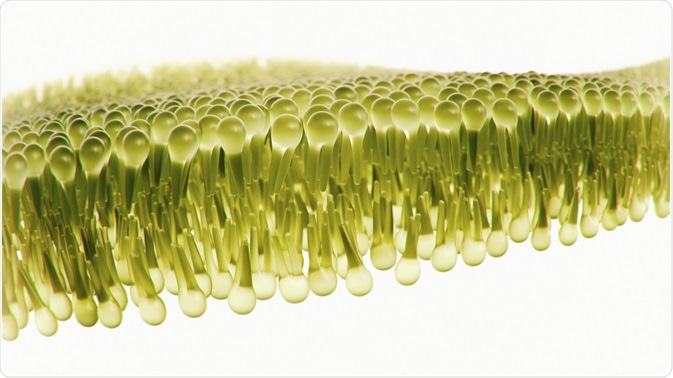What is lipidomics?
The discipline of lipidomics refers to the large-scale study and characterization of the pathways and networks of cellular lipids in humans and other biological systems.
This involves determining their full biological roles and functions, how they are involved in protein expression and gene regulation, and how their expression relates to pathology.

Image Credit: Crevis/Shutterstock.com
Lipid profiles have been shown to correlate with numerous human diseases that are at least, in part, related to lifestyle, and therefore have the potential to be prevented.
Diseases and illnesses such as atherosclerosis, Alzheimer's disease, cancer, diabetes, kidney disease, and obesity are some of those that have been related to certain lipid profiles.
Performing lipidomic studies has emerged as an effective approach to uncovering new clinical biomarkers of these diseases, as well as deepening our knowledge of how they progress and respond to treatment.
Lipidomics has become a vital tool in the development of new preventative and therapeutic approaches to disease.
Why is standardization needed in lipidomics?
While lipidomics has increased in popularity and importance, there is a lack of standardization across studies.
Researchers are currently using numerous mass spectrometric technologies to assess lipid specimens, which are then being analyzed using different techniques.
There is no established best-practice methodology. This has led to inconsistency across lipidomics studies, making them difficult to compare and replicate.
Often, absolute lipid concentrations are not reported in the data, and findings are presented in vastly different ways. This has caused an inconsistency in quality across studies, which is slowing down the potential advancements that lipidomics could make within the biological sciences.
There is a need to establish common standards across lipidomic studies, however, standardization is not a simple task. Below, we discuss the challenges facing the standardization of lipidomics.
Challenges in standardization
First, lipidomics differs in some key aspects in comparison to other fields of the “omics”. For this reason, protocols for the other omics cannot be simply adapted for use in lipidomics.
Entirely new guidelines need to be established, which inevitably requires a lengthy and complex process.
Experts need to be called upon from across the field to gain a thorough understanding of what best practices should be. This can be incredibly time consuming and resource-dependent.
Next, there is a disparity in the technologies used in the field of lipidomics, which is causing problems with reproducibility and discrepancies in reported data.
In developing a standardized methodology, some technologies may be omitted from use in lipidomics, and others may be called upon.
The challenge here is that equipment can be costly to research labs, and not all labs will have the same equipment.
In choosing methods that should become standard, there may be multiple technologies to choose from that have the same function, selecting one over the other for standardization may be difficult if there is not much difference between the advantages and disadvantages of each method.
The selection of particular technologies to be used as a standard protocol may cause some laboratories to incur extra costs to acquire new equipment. Or it could also cause some labs to decide to go against the standardized protocol when running lipidomics studies due to them wanting to use their equipment.
This defeats the purpose of establishing standardization in the first place.
By their nature, analyses of lipidomic data are complex, as the data is so rich. Because of this richness, there are many suitable ways to analyze the samples, depending on the type of study, hypotheses, type of sample, etc.
However, while this is true, there is a need to standardize data analysis to ensure studies can be compared and replicated. This is particularly difficult given the fact that there is no right or wrong way to do this.
In some cases, semiquantitative approaches are suitable for lipidomic studies, such as those that are exploring biomarkers or assessing changes in known lipid species.
However, as a general rule, it is recommended that in establishing standard protocol, lipidomics studies should be designed so that quantitative analyses can be applied to allow for the study of the interplay among lipids in biological membranes.
For some studies, it is not possible to follow specific guidelines when it comes to analytical methods, as those studies involving a large number of lipid species require the application of bespoke analytical approaches, and therefore, cannot follow protocol.
Overall, there are some major hurdles to overcome when establishing standardization of the lipidomic approach.
However, without it, the advancement of lipidomics will be limited, which will harm the areas of study that have already begun to benefit from it.
Considering the role lipidomics is already playing in developing our understanding of the disease, the prompt and accurate establishment of standardized guidelines is of utmost importance.
Sources:
- Han, X. (2017). Lipidomics for precision medicine and metabolism: A personal view. Biochimica et Biophysica Acta (BBA) - Molecular and Cell Biology of Lipids, 1862(8), pp.804-807. https://www.ncbi.nlm.nih.gov/pmc/articles/PMC5476489/
- Lipidomics needs more standardization. (2019). Nature Metabolism, 1(8), pp.745-747. https://www.nature.com/articles/s42255-019-0094-z#citeas
- Lv, J., Zhang, L., Yan, F. and Wang, X. (2018). Clinical lipidomics: a new way to diagnose human diseases. Clinical and Translational Medicine, 7(1). clintransmed.springeropen.com/.../s40169-018-0190-9#citeas
- Zhao, Y., Cheng, X. and Lin, R. (2014). Lipidomics Applications for Discovering Biomarkers of Diseases in Clinical Chemistry. International Review of Cell and Molecular Biology, pp.1-26. https://www.ncbi.nlm.nih.gov/pubmed/25376488
Further Reading
Last Updated: Mar 20, 2020